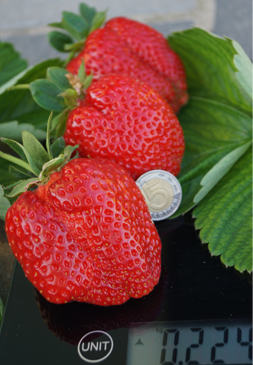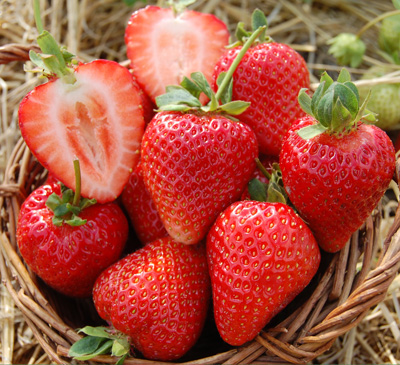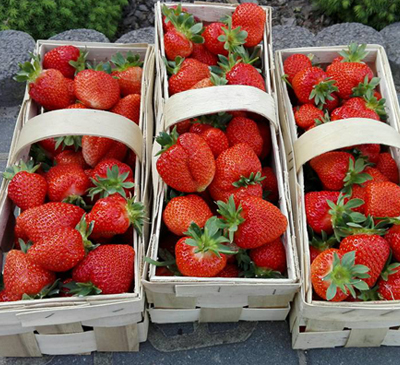
Grandarosa
Origin: Grandarosa ('Granda' x 'Camarosa') accepted for testing in Research Centre for Cultivar Testing (COBORU) and Exclusive Rights Protection Book (KO) under number T-03021-12 on 17.01.2011 year. The variety will be entered into the National Register of Varieties of Fruit Plants (KR) at the beginning of 2015.
Plant: growth strong, habitus is loose and high, phyllotaxis is medium-abundant. Leaves are light green, with rather intensive gloss, slightly concave, with serrated, obtuse (semicircular) edges. The stolons are numerous, poorly hairy, with a delicate anthocyanin colour. Inflorescences grow to the surface of the leaves, but some of them may be hidden in the leaves. Flowering is plentiful. The flowers are large, bisexual, the cup is much smaller than the corolla
Fruits: large and very large, conical, very shapely, orange-red, uniformly stained, with intense shiny, firm (firmer than fruits of 'Elsanta' variety), with a recessed nutlets, moderately aromatic and very tasty. The pap is bright red; air sac is medium size; the cup is adjacent to the fruit, with a diameter close to the diameter of the fruit; the sepals are partly turned back, it is moderately hard to separate them from the fruit.
Other features: the variety is medium early, distinguished by rich fruitage. Fruits are not very susceptible to gray mold. Plants have a low susceptibility to the white blotch and powdery mildew, but are moderately sensitive to red blotch and verticilliose. They are also endured for freezing.
Plant: growth strong, habitus is loose and high, phyllotaxis is medium-abundant. Leaves are light green, with rather intensive gloss, slightly concave, with serrated, obtuse (semicircular) edges. The stolons are numerous, poorly hairy, with a delicate anthocyanin colour. Inflorescences grow to the surface of the leaves, but some of them may be hidden in the leaves. Flowering is plentiful. The flowers are large, bisexual, the cup is much smaller than the corolla
Fruits: large and very large, conical, very shapely, orange-red, uniformly stained, with intense shiny, firm (firmer than fruits of 'Elsanta' variety), with a recessed nutlets, moderately aromatic and very tasty. The pap is bright red; air sac is medium size; the cup is adjacent to the fruit, with a diameter close to the diameter of the fruit; the sepals are partly turned back, it is moderately hard to separate them from the fruit.
Other features: the variety is medium early, distinguished by rich fruitage. Fruits are not very susceptible to gray mold. Plants have a low susceptibility to the white blotch and powdery mildew, but are moderately sensitive to red blotch and verticilliose. They are also endured for freezing.
The variety is recommended both for commercial plantations and for amateur cultivation.
"Grandarosa variety was bred at the Research Institute of Horticulture in Skierniewice. The description and photos of this variety comes from the Research Institute of Horticulture offer implementation (authorship: Dr Agnieszka Masny and prof. Edward Żurawicz)".
*Licensed variety. Varieties cannot be reproduced and sold, and according to new legislation cannot be duplicated for one's own needs.
"Grandarosa variety was bred at the Research Institute of Horticulture in Skierniewice. The description and photos of this variety comes from the Research Institute of Horticulture offer implementation (authorship: Dr Agnieszka Masny and prof. Edward Żurawicz)".
*Licensed variety. Varieties cannot be reproduced and sold, and according to new legislation cannot be duplicated for one's own needs.


